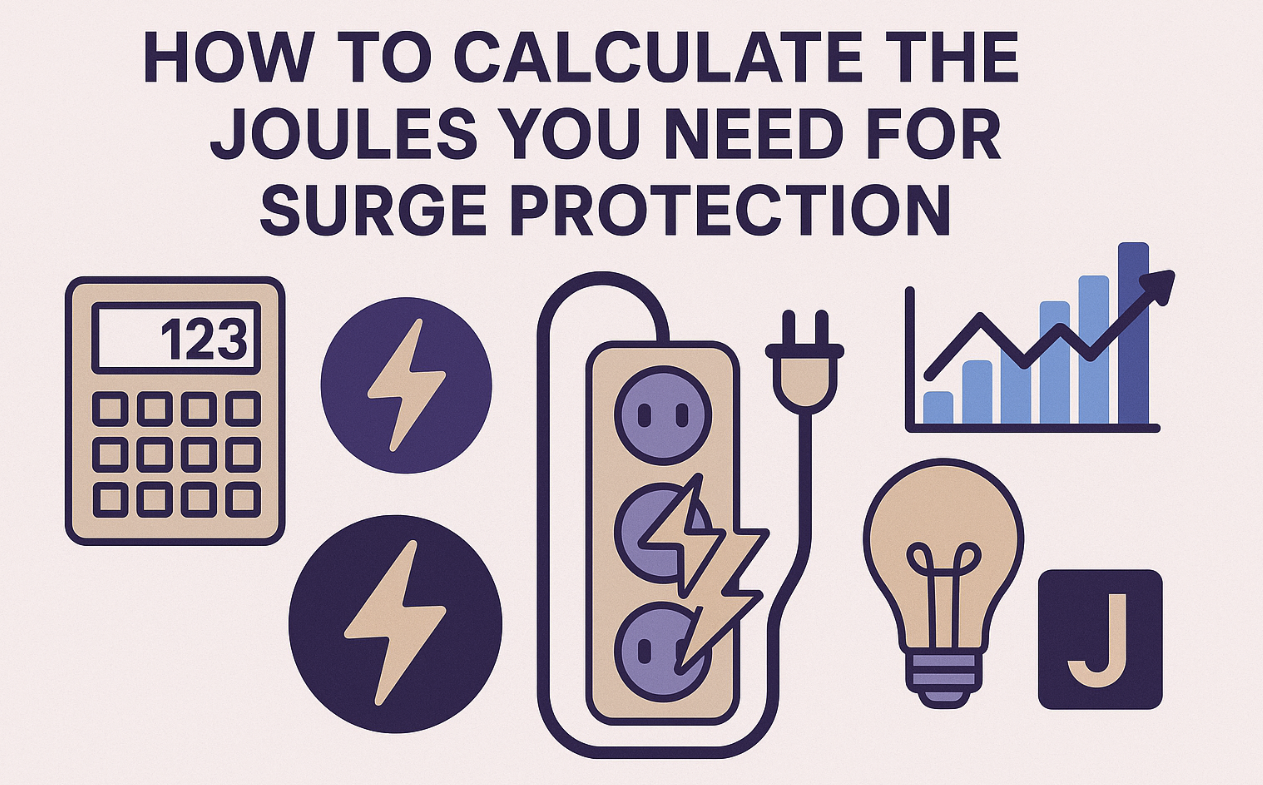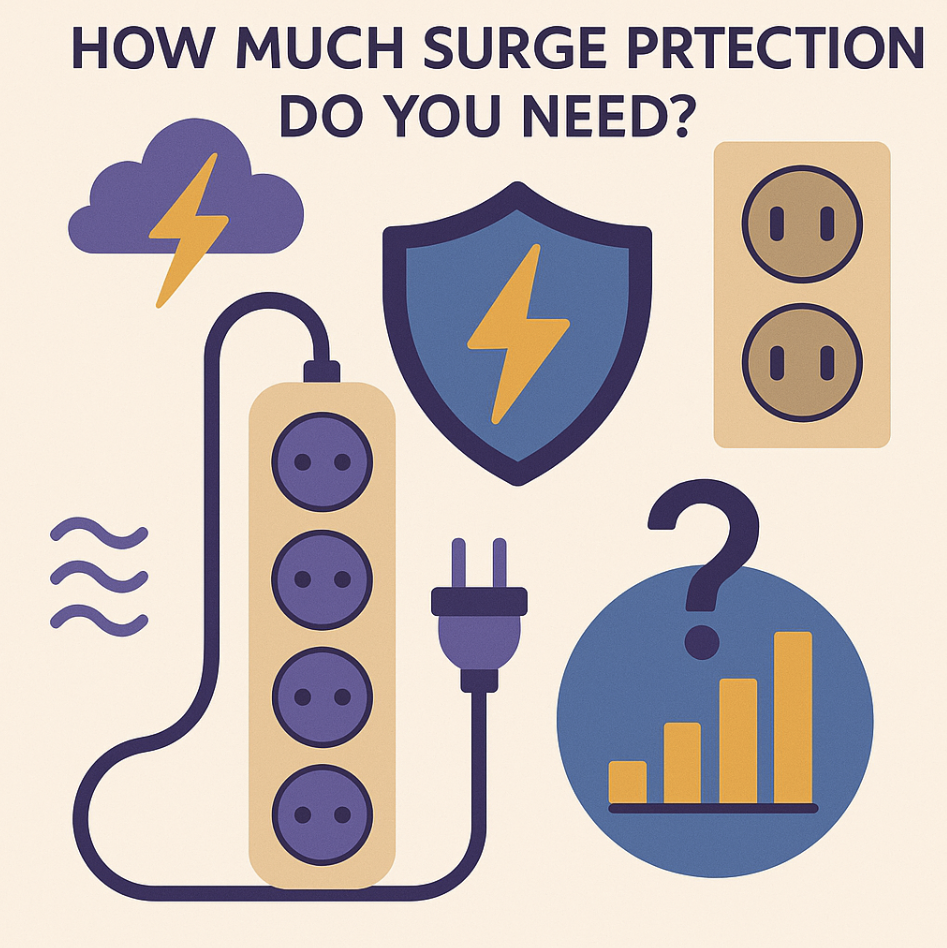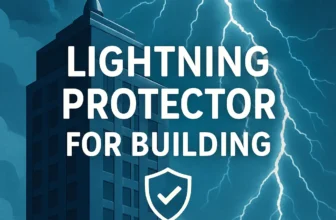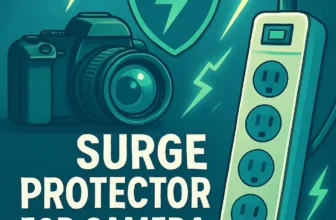Published By: Sean Hudson | Last updated on September 19, 2025 and reviewed by Editorial Team

Let’s talk about joules. Ever wondered what they mean when it comes to surge protection? Joules measure energy, and in the world of surge protection, it means how much energy a device can absorb before failing. Think of it like a shield for your electronics. The higher the joule rating, the stronger the shield.
Why does this matter?
Power surges happen more often than you might think. Lightning strikes, downed power lines, or even your fridge kicking on can send a sudden spike of electricity through your home. Without enough joule protection, your expensive gadgets—such as TVs, gaming consoles, or computers—could be damaged or destroyed in an instant. Choosing the right joule rating isn’t just smart; it’s essential.
So, how much surge protection do you need? That depends on what you’re protecting and how valuable it is to you. Read on and let’s figure it out together.
What Are Joules and Their Role in Surge Protection?
Understanding Joules
Definition and Measurement of Joules
Let’s break it down. A joule is a unit of energy in the International System of Units (SI). It’s the work done when a force of one newton moves an object one meter. In electrical terms, it’s the energy released when a current of one ampere flows through a resistance of one ohm for one second. Sounds technical, right?
Think of it this way: joules measure how much energy something can handle.
When it comes to surge protection, joules indicate the amount of energy a surge protector can absorb before it stops functioning. For example, a surge protector with an 800-joule rating can handle eight surges of 100 joules each. Once it absorbs that much energy, it’s done.
How Joules Relate to Energy Absorption
Joules are like a sponge for energy. When a power surge hits, the surge protector absorbs the extra energy to keep it from reaching your devices. The higher the joule rating, the more energy it can soak up. This is why understanding joules is key to choosing the right surge protector for your needs.
Importance of Joules in Surge Protectors
How Surge Protectors Absorb Voltage Spikes
Surge protectors act as shields against power surges. These surges can come from lightning strikes, electrical grid fluctuations, or even appliances like your air conditioner. When a surge happens, the surge protector’s components, like Metal Oxide Varistors (MOVs), absorb the excess energy. This prevents the surge from frying your electronics.
The joule rating of a surge protector determines the amount of energy it can safely handle. For instance, a protector rated at 3,000 joules can absorb up to 3,000 joules of energy over its lifetime. Each surge chips away at this capacity, so it’s important to monitor your surge protector’s performance.
Why Higher Joule Ratings Provide Better Protection
Higher joule ratings mean better protection. A surge protector with a high joule rating can handle stronger surges and last longer. For example, a 3,000-joule protector offers more robust defense than a 1,000-joule one. This is especially important for high-value electronics like gaming consoles or home theater systems.
Investing in a surge protector with a higher joule rating gives you peace of mind. It ensures your devices are safe from unexpected power surges, regardless of their severity.
How Much Surge Protection Do I Need? A Step-by-Step Guide
Step 1: Identify the Devices You Want to Protect
Common Electronics and Their Sensitivity
Let’s start by listing the devices you want to protect. Some electronics are more sensitive to power surges than others. Here’s a quick rundown of the most vulnerable ones:
-
Computers and laptops
-
Televisions and home theater systems
-
Gaming consoles and smart home devices
-
Home office equipment
These devices often have delicate internal components that can’t handle sudden voltage spikes. If you’re like me, you probably rely on many of these every day. Protecting them isn’t just about convenience—it’s about avoiding costly replacements.
Evaluating the Value of Your Devices
Now, think about the value of your electronics. Are they expensive to replace? Do they store important data or memories? For example, a gaming PC or a smart TV can cost thousands of dollars. Losing them to a surge would be a nightmare.
Prioritize protecting high-value items first.
Step 2: Determine the Power Consumption of Your Devices
Finding Wattage and Voltage Information
Next, determine the power consumption of your devices. This step is easier than it sounds. Here’s how you can do it:
-
Use the formula: watts = amps × volts.
-
If you don’t know the amps or volts, rearrange the formula to find what you need.
-
Plug in a wattage meter to measure the power consumption directly.
-
Turn on the device and compare the wattage reading to its rating.
For the most accurate results, monitor the wattage over several hours. This gives you an average power consumption, which helps calculate your surge protection needs.
Why Power Consumption Affects Joule Requirements
Power-hungry devices need more joule protection. A gaming console or a home theater system draws more power than a lamp or a phone charger. The higher the power consumption, the more energy a surge protector must absorb during a spike.
Step 3: Match Devices to Recommended Joule Ratings
Recommended Joule Ratings for Common Devices
Here’s a handy table to help you match your devices to the right joule rating:
|
Device |
Recommended Joule Rating |
|---|---|
|
Laptop/Computer |
600-1200 Joules |
|
Television |
1000-2000 Joules |
|
Home Theater System |
2000-4000 Joules |
|
Gaming Console |
1000-2000 Joules |
Using this table, you can quickly decide how much surge protection each device needs.
Examples of Calculating Joule Needs for Multiple Devices
Let’s say you want to protect a gaming console (1000-2000 joules) and a home theater system (2000-4000 joules). Add their upper limits together to get 6000 joules. A surge protector with a 6000-joule rating ensures both devices stay safe.
Planning for multiple devices? Always aim for a higher joule rating to ensure complete coverage.
Step 4: Plan for Future Needs
Choosing a Higher Joule Rating for Added Protection
When it comes to surge protection, thinking ahead can save you a lot of headaches. Choosing a surge protector with a higher joule rating than you currently need is a smart move. Why? It’s all about durability and better protection. A higher joule rating means the surge protector can handle multiple power spikes over time. This ensures your devices stay safe, even during repeated surges.
Here’s a quick breakdown of the advantages:
|
Advantage |
Explanation |
|---|---|
|
Better protection against surges |
Higher joule ratings absorb more energy, keeping your devices safer. |
|
Longer lifespan |
They last longer because they can handle more energy before wearing out. |
|
Handles multiple spikes effectively |
Designed to manage several surges, ensuring consistent protection for devices. |
Think of it like buying a sturdier umbrella. Even if the storm gets worse, you’ll stay dry. A surge protector with a higher joule rating works the same way—it’s ready for whatever comes its way.
Accounting for Additional Devices or Upgrades
Let’s face it. You’re probably going to add more gadgets to your setup in the future. Whether it’s a new gaming console, a smart home device, or an upgraded TV, your surge protector needs to keep up. Planning for these upgrades now can save you from having to replace your surge protector later.
Here’s how you can prepare:
-
Regularly inspect your surge protector for wear and tear.
-
Compare its joule rating to newer models. If it’s significantly lower, consider upgrading.
-
Invest in a surge protector with extra outlets. This ensures you have room for new devices.
-
Look for features like USB ports or coaxial connectors if you plan to add modern electronics.
Pro Tip: Always choose a surge protector with a joule rating that exceeds your current needs. It’s a cost-effective way to protect your electronics and avoid future hassles.
Planning ahead doesn’t just protect your devices—it protects your peace of mind. A little foresight now can save you from big problems later.
Additional Considerations for Choosing Surge Protection
Features to Look For
LED Indicators and Their Importance
Ever noticed those tiny LED lights on a surge protector? They’re more important than they seem. These indicators tell you if the surge protection is still active. When the light is on, your devices are safe. If it’s off or blinking, the surge protector may have reached its energy limit and needs replacement. Think of it as a health check for your surge protection.
Without this feature, you’d never know if your devices are vulnerable to power surges.
Number of Outlets and USB Ports
Let’s talk about convenience. A good surge protector should have enough outlets for all your devices. For most households, 6 to 8 outlets work fine. But if you’ve got a home office or entertainment setup, go for 10 or more. USB ports are another handy feature. They let you charge phones and tablets without needing extra adapters.
It’s all about making life easier while keeping your gadgets safe.
Understanding Surge Protector Lifespan
Why Surge Protectors Wear Out Over Time
Surge protectors don’t last forever. Each time they absorb a power surge, their capacity decreases. Big surges, like those from lightning strikes, can cause significant wear. Even small, frequent surges chip away at their effectiveness.
Over time, heat from sustained over-voltage conditions can damage internal components. This is why regular checks are crucial.
How to Know When to Replace Your Surge Protector
So, how do you know it’s time for a new surge protector? Look for frayed cords or loose outlets. These are clear signs it’s no longer reliable. Check the LED indicator. If it’s blinking or off, the surge protection is likely depleted.
Also, compare its joule rating to newer models. If it’s much lower, upgrading is a smart move.
Potential Challenges in Selecting the Right Surge Protector
Misinterpreting Joule Ratings
Joule ratings can be confusing. Some people think all surge protectors offer the same level of protection. That’s not true. Higher joule ratings mean better protection and the ability to handle multiple power surges.
Think of joules as the protector’s energy bank. The more it has, the better it can shield your devices.
Overlooking Device Power Requirements
Another common mistake is ignoring your devices’ power needs. Always choose a surge protector with a wattage rating higher than your total device consumption. This ensures it can handle the load without overheating.
A higher joule rating also adds an extra layer of safety.
Common Mistakes to Avoid When Choosing Surge Protection
Selecting a Surge Protector with Too Low a Joule Rating
Risks of Insufficient Protection
Choosing a surge protector with a low joule rating might seem like a cost-saving move, but it’s a risky gamble. Here’s why:
-
It won’t absorb enough energy during power surges, leaving your devices exposed to harmful voltage spikes.
-
Sensitive electronics, like computers or gaming consoles, can suffer irreversible damage.
-
Repairs or replacements for damaged devices can cost you hundreds, if not thousands, of dollars.
I’ve seen people underestimate their needs, only to regret it later. A low joule rating is like using a paper umbrella in a thunderstorm—it just won’t hold up.
How to Avoid Underestimating Your Needs
Start by listing all the devices you want to protect. Then, check their power consumption and match them to the recommended joule ratings. Always aim for a higher rating than you think you need. This ensures your surge protector can handle multiple power surges over time.
Trust me, it’s better to overestimate than to risk losing your valuable electronics.
Ignoring the Lifespan of Surge Protectors
Why Old Surge Protectors May Fail
Surge protectors don’t last forever. Over time, their components degrade due to:
-
Regular power fluctuations.
-
Lightning strikes that overwhelm their capacity.
-
High-voltage surges from grid issues.
-
Daily wear and tear from normal use.
An old surge protector might look fine on the outside, but it could be a ticking time bomb. Once it reaches its maximum joule rating, it can no longer absorb energy effectively.
Signs It’s Time to Replace Your Surge Protector
Here’s how I keep my surge protection up to date:
-
Inspect for physical damage, like frayed cords or loose outlets.
-
Compare its joule rating to newer models. If it’s significantly lower, replace it.
-
Follow the general rule of replacing surge protectors every 2 to 3 years.
If your surge protector is several years old, it’s time for an upgrade. Newer models offer better protection and peace of mind.
Not Considering the Number of Devices
Overloading a Surge Protector
Plugging too many devices into one surge protector is a common mistake. This can:
-
Exceeding the wattage and joule ratings reduces its effectiveness.
-
Burn out the surge protector, leaving your devices unprotected.
-
Tripping your circuit breaker can cause inconvenience and potential damage.
I’ve learned to always check the wattage and joule limits before plugging in multiple devices. Overloading isn’t worth the risk.
Planning for All Connected Devices
When choosing a surge protector, think about your current and future needs. Look for one with enough outlets for all your devices. For most households, 6 to 8 outlets work well. Larger setups might need 10 or more.
Also, consider features like USB ports for added convenience.
Planning ahead saves you from needing multiple surge protectors or risking overload. It’s a simple step that makes a big difference in your surge protection strategy.
Choosing the right joule rating for your surge protector isn’t just about numbers—it’s about protecting what matters most. A higher joule rating means better protection, especially for larger devices like desktop computers or gaming consoles, which need at least 2,000 joules. Smaller gadgets, like cell phones, can get by with around 1,000 joules, while basic devices might only need 500.
Matching the joule rating to your devices ensures they stay safe from unexpected power surges.
Don’t forget to think about the value of your electronics and how much you rely on them. Whether it’s a laptop for work, a smart TV for entertainment, or a router for your smart home, these devices are essential. Planning for future upgrades by choosing a surge protector with a higher joule rating and extra outlets is a smart move. It saves you from having to replace your surge protector down the road.
Investing in a high-quality surge protector is a small price to pay compared to replacing expensive electronics. It’s not just about financial savings—it’s about peace of mind. As we depend more on technology for work, education, and entertainment, protecting our devices becomes even more critical.
A reliable surge protector ensures your gadgets stay operational and safe, no matter what.








